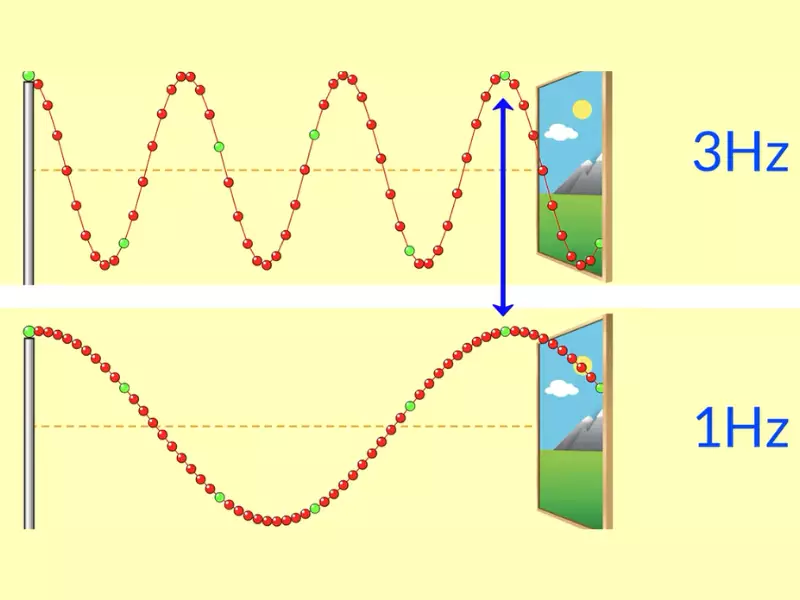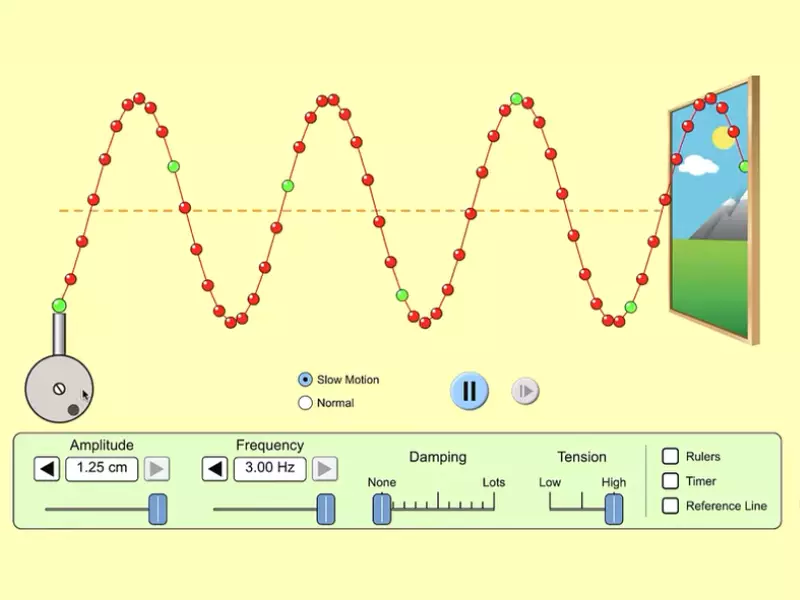The intricate dance between frequency and speed is a foundational concept in the realm of physics, with implications that stretch far and wide across various scientific and technological fields. Frequency, or the number of occurrences of a repeating event per unit time, and speed, the rate at which an object covers distance, are intertwined in ways that govern everything from the light we see to the sounds we hear.
At its core, the relationship between frequency and speed can be summarized succinctly: the speed of a wave is equal to the product of its frequency and wavelength. This means that for waves traveling through a medium, their speed changes with adjustments in frequency and wavelength. This principle is vital for understanding how different types of waves behave and interact with their environments.
The study of this relationship not only sheds light on the fundamental properties of waves but also has practical applications in various industries. From telecommunications, where it underpins the transmission of data, to medical imaging technologies like ultrasounds, the interplay between frequency and speed is crucial. It allows us to harness waves in ways that improve our quality of life, making it a topic of both theoretical interest and practical importance.

Basics of Waves
Wave Characteristics
Waves are fundamental to understanding how our world works, from the ripples on a pond to the transmission of light and sound. At their core, waves are disturbances that transfer energy from one point to another without the physical transfer of matter. They are characterized by four main parameters: wavelength, amplitude, frequency, and speed.
- Wavelength is the distance between two consecutive points in phase on a wave, such as from crest to crest or trough to trough.
- Amplitude refers to the maximum displacement of a point on the wave from its rest position, essentially measuring the wave’s strength or intensity.
- Frequency is the number of waves that pass a given point in a specific time period, typically one second. It is measured in Hertz (Hz).
- Speed represents how fast the wave is moving, calculated as the product of the wave’s frequency and its wavelength.
Understanding these characteristics helps in analyzing how waves interact with the environment and with each other, impacting everything from communication technologies to medical imaging.
Types of Waves
Waves can be classified into two main types: mechanical waves and electromagnetic waves. This differentiation is crucial in understanding the broad applications and behaviors of waves across different media.
- Mechanical waves require a medium (such as air, water, or solids) to propagate. They transfer energy through the vibration of the medium’s particles. Examples include sound waves and seismic waves.
- Electromagnetic waves, on the other hand, do not require a medium and can travel through the vacuum of space. These waves, which include light, X-rays, and radio waves, are essential for various technologies and our understanding of the universe.
The relevance of distinguishing between these types of waves lies in their distinct properties and applications. For instance, while both can carry energy across distances, their methods of interaction with materials differ significantly, affecting how they are utilized in communication, imaging, and exploration technologies.
Frequency Explained
Definition and Units
Frequency is a key concept in the study of waves, describing how often a wave oscillates or cycles over a set period. It quantifies the number of complete cycles that occur each second and is measured in units called Hertz (Hz). One Hertz signifies one cycle per second, providing a standard measure for comparing the frequency of different waves.
Factors Affecting Frequency
Several factors can influence the frequency of a wave, including the medium through which it travels, the source of the wave, and the surrounding environment:
- The medium’s properties, such as density and elasticity, can affect how quickly a wave can oscillate.
- The source of the wave, including its nature and how it generates waves, directly determines the frequency.
- Environmental conditions like temperature and pressure can alter the medium’s properties, thereby impacting the wave’s frequency.
Understanding these factors is crucial for controlling and predicting the behavior of waves in various applications, from tuning musical instruments to designing efficient communication systems.
Speed of Waves
Speed Definition
The speed of a wave is a measure of how fast it travels through a medium. This speed can vary widely depending on the type of wave and the medium it traverses. Speed is generally measured in meters per second (m/s) and is a critical factor in determining how waves interact with objects and with each other.
Determinants of Speed
The speed of a wave is influenced by factors such as the medium, temperature, and pressure:
- Different media can dramatically alter the speed of a wave. For instance, sound travels faster in water than in air.
- Temperature changes can affect the density and elasticity of a medium, thus impacting wave speed.
- Pressure variations can also modify the characteristics of the medium, further influencing how quickly a wave can move.
These determinants play a vital role in applications ranging from underwater sonar to the propagation of light in optical fibers.
Relationship Overview
Formula Connection
The relationship between frequency and speed is encapsulated in the fundamental formula: Speed = Wavelength × Frequency. This equation links the three critical characteristics of waves, demonstrating how changes in frequency and wavelength directly affect wave speed.
Theoretical Background
The reason speed depends on both frequency and wavelength stems from how waves propagate. As frequency increases, for a given speed, the wavelength must decrease, and vice versa. This interdependence is crucial for understanding wave behavior, especially in scenarios where manipulating wave speed is necessary or beneficial.
Real-World Applications
Communication Technologies
In the realm of communication, the interplay between frequency and speed is fundamental. High-frequency radio waves can carry more data over shorter distances, ideal for cellular and Wi-Fi communications, while lower-frequency waves, traveling at the same speed, offer longer range but less data capacity. This balance is crucial in designing networks that are both efficient and expansive.
Medical Imaging
Ultrasound technology exemplifies the importance of frequency and speed in medical imaging. High-frequency sound waves provide detailed images of internal organs, as the speed of these waves in human tissue allows for precise reflection patterns that form clear images. Adjusting frequency and understanding wave speed are vital for optimizing image quality and diagnostic value.
Astronomy
Astronomy relies heavily on analyzing electromagnetic waves of various frequencies and speeds to understand celestial objects and phenomena. The speed of light in a vacuum is a constant, but by studying different frequencies of light (from radio waves to gamma rays), astronomers can gather a wealth of information about the universe’s composition, dynamics, and history.

Frequency Modulation and Speed
FM and Signal Clarity
Frequency modulation (FM) is a technique used in communications to enhance the clarity and speed of signal transmission. By varying the frequency of the carrier wave in accordance with the information being sent, FM improves the signal-to-noise ratio and reduces the impact of interference. This is because noise typically affects the amplitude of a signal, and since FM focuses on frequency changes, the transmitted information remains largely unaffected by noise.
The advantages of FM over amplitude modulation (AM) include:
- Improved signal clarity: Less susceptible to electrical noise and interference.
- Higher quality sound: Provides better sound quality for audio transmissions.
- Increased data capacity: Allows for the transmission of more data in the same bandwidth, enhancing communication speed.
This principle is widely applied in radio broadcasting, television audio transmission, and data communication networks, offering clearer and more reliable communication channels.
Technological Implications
The impact of frequency modulation and wave speed on data transmission and reception technologies is profound. In digital communications, the concept of frequency shift keying (FSK), a form of frequency modulation, is utilized to transmit digital signals over various media. This has direct implications for:
- Wireless networks: Enhancing the speed and reliability of wireless internet and mobile networks.
- Satellite communication: Improving the quality and efficiency of satellite links, crucial for GPS, satellite TV, and global communications.
- Fiber optics: Enabling high-speed data transmission over optical fibers by modulating light waves.
These technologies underline the importance of understanding and manipulating frequency and speed to meet the increasing demand for faster, clearer, and more secure communication systems.
Challenges and Considerations
Limitations in Control
Despite the advancements in wave technology, there are inherent limitations and challenges in controlling frequency and wave speed, particularly in specific applications. These limitations are often due to:
- Physical constraints: The medium through which waves propagate can limit the possible frequencies and speeds, especially in mechanical waves.
- Technological limits: The current state of technology may not always allow for precise control or modification of wave properties to achieve desired outcomes.
- Interference and bandwidth restrictions: Especially in crowded spectrums, managing interference and adhering to regulatory bandwidth limits can restrict how frequency and speed can be adjusted.
These constraints necessitate ongoing research and development to overcome or mitigate limitations, pushing the boundaries of what is currently possible in wave-based technologies.
Environmental Impact
Environmental factors play a significant role in complicating the relationship between frequency and speed. The propagation of waves, whether electromagnetic or mechanical, can be affected by conditions such as:
- Atmospheric conditions: Temperature, humidity, and atmospheric pressure can affect the speed of sound waves, while electromagnetic waves can be influenced by ionospheric conditions.
- Physical barriers: Mountains, buildings, and other obstacles can reflect, refract, or absorb waves, affecting both their speed and frequency.
- Human-made interference: From electromagnetic noise from electronic devices to the physical disruption of sound waves, human activities can significantly impact wave propagation.
Frequently Asked Questions
What is Wave Frequency?
Wave frequency refers to the number of cycles a wave completes in a specific amount of time, typically measured in Hertz (Hz). It represents how often the particles of a medium vibrate when a wave passes through it.
How Does Speed Affect Wave Frequency?
Speed affects wave frequency in that a higher speed allows for more wave cycles to pass a given point per unit time if the wavelength remains constant. Conversely, changes in medium or energy can alter both speed and frequency.
Can Frequency Change Without Affecting Speed?
In certain conditions, such as electromagnetic waves traveling through a vacuum, the speed remains constant, and changes in frequency directly influence the wavelength. However, in mediums like air or water, both frequency and speed can be affected by external factors.
What Role Does Medium Play in the Frequency-Speed Relationship?
The medium through which a wave travels significantly impacts its speed and, consequently, its frequency. Different materials have different properties that can alter the speed of wave propagation, affecting the observed frequency.
Conclusion
Understanding the nuanced relationship between frequency and speed unveils a layer of complexity in the physics of waves that has direct applications in our daily lives and advanced technological systems. It’s a testament to the interconnectedness of scientific principles and their practical utility, bridging theoretical physics with real-world applications.
As we continue to explore and harness the potential of waves across different mediums and technologies, appreciating the delicate balance between frequency and speed becomes increasingly important. This foundational knowledge not only enriches our understanding of the natural world but also empowers us to innovate and improve upon the technologies that shape our future.
